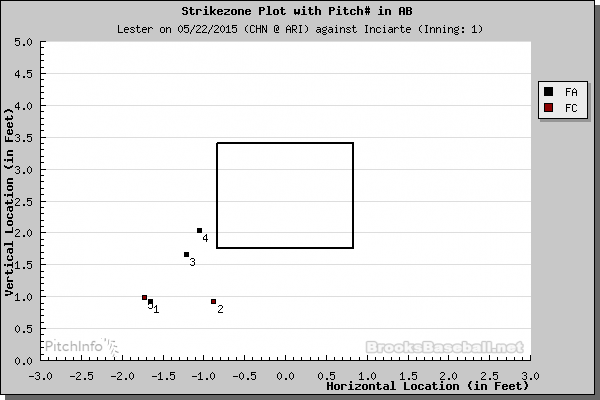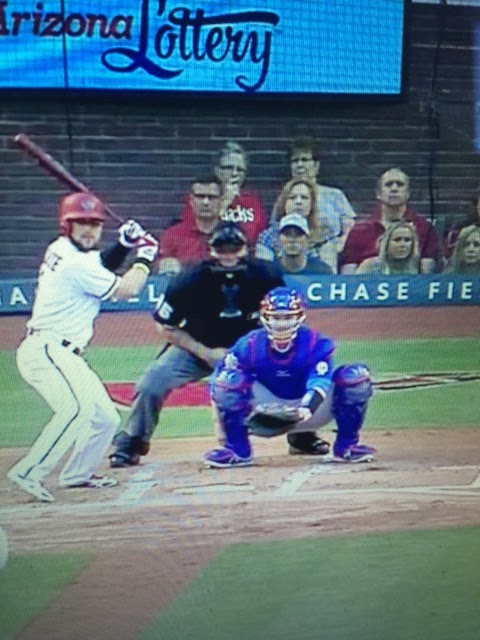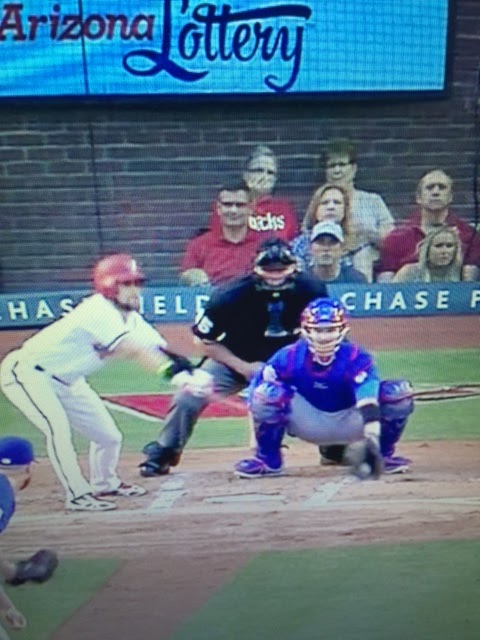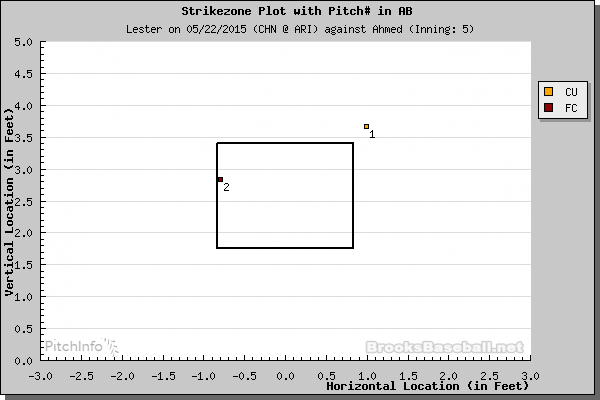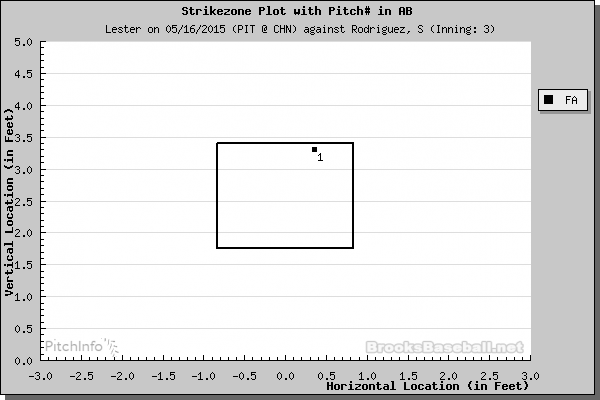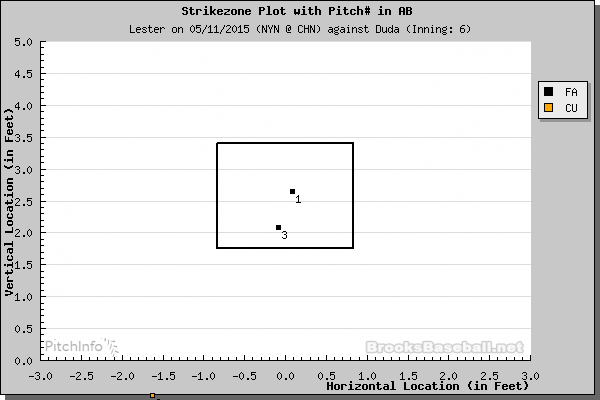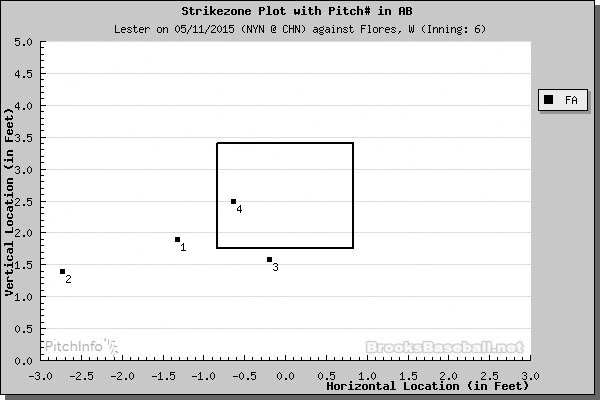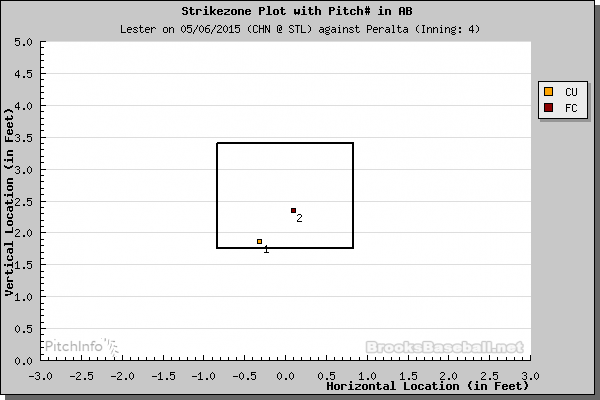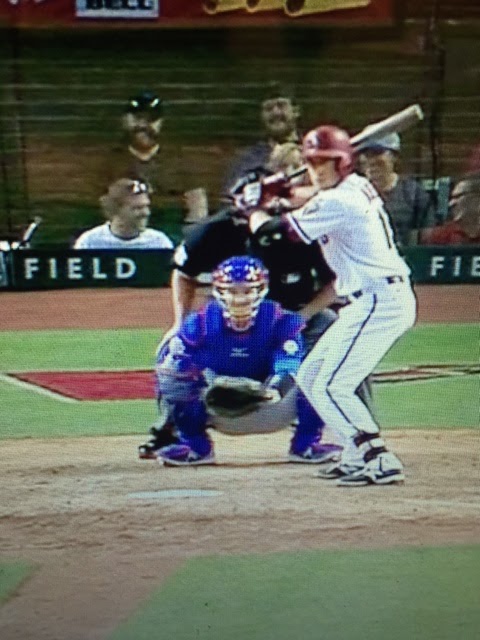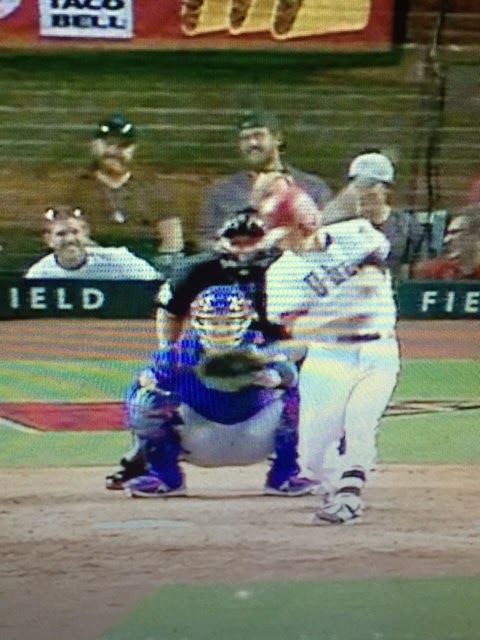Photo courtesy of Matt Kartozian-USA TODAY Sports
Date: May 22
Opponent: Arizona Diamondbacks
Location: Chase Field
Introduction
Baseball, as I wish a famous baseball figure had once said so I would have a decent lede quote, is a frustrating game. On Friday night at the Arizona Diamondbacks, Jon Lester pitched a solid, efficient game. It was undoubtedly one of his two or three best starts in a Cubs uniform, and certainly better than his May 11 start against the New York Mets when he surrendered two home runs and four walks in six innings.
Against the Mets, Lester picked up the victory. Against the Diamondbacks, Lester gave the Cubs a great start, but at the end of the night, neither he nor the team had much to show for the effort.
At Chase Field, Lester threw his fewest pitches of the season through five innings (66) and six innings (77), and did not have a twenty pitch inning for only the second start of the season. There was not a high amount of traffic on the basepaths, which his marked even some Lester’s better Cubs starts. Friday night’s game was only the third time this season that Lester has averaged a baserunner or fewer per inning. He was not overpowering, as his four strikeouts and seven whiffs matched season-low marks, but he made fairly quick work of Arizona hitters.
And the Diamondbacks presented stiffer competition for Lester, unlike three of his previous four starts, when he faced three of the worst offenses in the National League (Pittsburgh Pirates, New York Mets, and Milwaukee Brewers). The Diamondbacks entered the game second in the NL in runs scored, but are doing it with moderate power numbers. As a team, they ranked fifth in slugging percentage and ninth in doubles, home runs, and ISO.
So, how are the Diamondbacks scoring so many runs in the season’s first quarter? It appears lots of base hits and putting the ball in play. Arizona entered Friday’s game leading the NL in team singles and batting average, while owning the fifth lowest strikeout rate and sixth highest on-base percentage. And as a team, they are having more success against left-handed pitchers, hitting .282/.354/.395.
The Diamondbacks have been led by the ridiculous Paul Goldschmidt, who entered the game destroying left-handed pitchers at a rate of .375/.444/.781. Overall, through the season’s first quarter, he has hit .322/.421/.603 with 20 extra-base hits. Against Lester, Goldschmidt went 2-for-3 with two singles, meaning he at least kept him the in the park. In fact, Lester pitched Goldschmidt fairly effectively, keeping the ball down, but as I tweeted after the first-inning RBI single:
#Lester made decent pitch to Goldschmidt on RBI single. There's a reason he has a 1.024 OPS #Cubs pic.twitter.com/2oXxIF3mvG
— Andrew Felper (@AndrewFelper) May 23, 2015
Despite his efficiency of pitches, Lester got ahead of just 16 of 28 batters (57.1 percent), his lowest total since his fourth start of the season (47.8 percent). In his three starts previous, Lester had gotten ahead of a combined 70 percent of batters. The Diamondbacks batters were fairly aggressive, as of the five hits, two came on the first pitch of the at-bat. Was this the result of Diamondbacks hitters making adjustments to Lester getting ahead of so many batters recently, including 80 percent against Pittsburgh last week? It certainly is worth monitoring in Lester’s coming starts.
My biggest question of Lester’s ninth start was could—and should—he have gone deeper into the game? He was at just 96 pitches, but he had thrown 106 or more pitches in three straight starts and Goldschmidt was due up second in the bottom of the eighth. Joe Maddon and Chris Bosio have shown a reluctance to allow Lester to start an inning if they didn’t think he would complete it. Only twice in 2015, and not since start number three against San Diego on April 19, has Lester been pulled from the game during the inning. It is a question that makes for good, nerdy debate, but has no real definite answer.
The end results were not favorable for Lester and the Cubs, but the staff ace looked sharp overall against a team and offense that is remaining in the thick of Wild Card contention. As another famous and nonexistent baseball figure once said, “Keep reading below to see Andrew Felper’s analysis of Lester’s ninth start of 2015.”
Traditional Line
7.0 IP, 5 H, 4 K, 2 BB, 2 ER
Pitch Breakdown
96 pitches (59 strikes)
| Total | Velocity (Max) | AVG | SLG | BABIP | |
| Four-Seam | 42 | 91.6 (94.0) | .125 | .375 | .143 |
| Cutter | 27 | 89.5 (92.8) | .222 | .556 | .200 |
| Sinker | 13 | 91.8 (93.0) | .000 | .000 | .000 |
| Change-Up | 3 | 85.6 (86.1) | 1.000 | 1.000 | 1.000 |
| Curveball | 11 | 75.1 (77.2) | .250 | .250 | .250 |
Lester’s four-seam fastball returned to its season average usage (44 percent), after dipping down to a combined 36 percent in his previous two starts. In those two games, opposing batters had hit the pitch a rate of .500/.529/1.063. While Diamondback hitters did little damage against the pitch, his velocity was the lowest of the season.
While Lester did surrender a home run to right-handed batting Nick Ahmed on a cut-fastball (see Key At-Bat section), his cutter to left-handed batters has done an abrupt and welcome turnaround from the season’s opening month. In four April starts, Lester threw the cutter 28 percent of the time to left-handed batters, who hit .417/.417/.500.
In five May starts, though, Lester has thrown the cutter 44 percent of the time to left-handed batters, more than any other pitch to lefties. They are hitting just .250/.294 /.250, with no extra-base hits. Lester is throwing the pitch with more frequency, and left-handers are having considerably less success.
You could see this improvement during the game’s first batter, Ender Inciarte. Lester fell behind 2-0, but, as you can see below, he came back with two four-seam fastballs on the outside corner for called strikes.
On the 2-2 pitch, David Ross moved a little further off the plate:
Lester threw an 89 mph cut fastball that cut and then some:
Inciarte flailed at the pitch, seemingly not prepared for a third consecutive fastball outside. In the season’s first month, we had grown accustomed to Heyward, Carpenter, Bruce, and Votto laying off Lester’s cut fastball. Now, Lester is using the pitch to put away left-handed batters. Also encouraging, Lester was able to locate his four-seamer to set-up his cutter.
The curveball was noticeably absent from Lester’s arsenal on Friday. After throwing a combined 47 curves in his last two starts, Lester threw just 11 (11.5 percent) against the Diamondbacks, his lowest total since he threw ten the third start of the season and second lowest percentage (11.2 percent) since Opening Night. As we have mentioned once, twice, or 398 times in the past few weeks, Lester’s curveball frequency decreases when he struggles to consistently get ahead of batters with his fastball.
Trends
After giving up just one home run in his first six starts, Lester has now surrendered five in his last four starts. It is the first time Lester has allowed home runs in four consecutive games since June 2013, when he allowed eight (!).
In this 2015 stretch, all five have come on four-seam or cut fastballs. As you will notice below if you keep reading (please!), all five have been on pitches left up and over the plate:
5/23 at Arizona, an 88 mph cut-fastball to Nick Ahmed (see Key At-Bat section)
5/16 vs. Pittsburgh, a 91.7 mph four-seam fastball to Sean Rodriguez:
5/11 vs. New York Mets, a 93 mph four-seam fastball to Lucas Duda
5/11 vs. New York, a 93 mph four-seam fastball to Wilmer Flores:
5/6 at St. Louis, an 89.5 mph cut-fastball to Jhonny Peralta:
All five home runs came on pitches where Lester missed Ross’s target.
During this four-game stretch, opposing batters are hitting .269/.347/.522 against Lester’s four-seam and cut-fastballs, which he has thrown a combined 69 percent of all pitches. That is right at his season average, and five percentage points above his career average. Including Friday’s game, Lester has been mostly successful at using those pitches to get ahead of batters. It just so happens that when he’s missed, the batters have not (How’s that for terrible wordplay?).
Just For Fun: If you remove the five home runs, batters are hitting .210/.300/.242 against Lester’s four-seamer and cutter in the past four games. That just goes to show you that when he has not missed up a handful of times, those two pitches have been effective for Lester.
Key At-Bat/Sequence
Inning: Fifth
Score: 2-1, Cubs
Situation: Ahmed leading off the inning
Batter(s): Nick Ahmed
After surrendering Goldschmidt’s RBI single in the first inning, Lester retired 11 of 13 batters. The Cubs offense climbed back to give Lester a 2-1 lead and had driven Josh Collmenter’s pitch count to nearly 100 pitches through five innings. Momentum, if such a thing exists, appeared to be with Lester and the Cubs.
Leading off the home half of the fifth, though, was Nick Ahmed, who entered the game with a .483 OPS and two extra-base hits in 2015.
Lester fell behind 1-0, as Ahmed laid off a curveball up and away. Ross then set up low and away:
Lester did come inside, but he left the 88 mph cutter up on the inside corner:
Ahmed pulled the pitch over the left-field fence, tying the game 2-2. It was just Ahmed’s second career home run in 191 career plate appearances. Against cut fastballs in 2015, Ahmed entered the game just for 1-for-10 with three strikeouts. It was the right pitch selection, just poor execution. As we noted last start after Lester gave up a home run to Pittsburgh’s Sean Rodriguez, “Few, if any, major-league hitters will miss a fastball at that velocity in that location, even one with a career .674 OPS.”
Keep In Mind
The totality of Lester’s damage came on two batters in the first inning (AJ Pollock’s triple and Goldschmidt’s single) and one batter in the fifth inning (Ahmed’s home run). Of the other 25 batters Lester faced, none reached third base. That is no small feat, considering the Diamondbacks are a solid offensive team, with six everyday players having a TAv of .260 or higher.
Conclusion
Lester has found a groove, despite Friday’s no-decision and continued binge of home runs on fastballs. He has now gone seven innings in four of five starts, and at least six innings in six straight starts. If Lester is able to get under control the home-run outbreak—six of the seven unearned runs he has allowed since May 6 have resulted from home runs—he appears to be in a virtually unhittable stretch.
Season-to-Date
4-2, 3.56 ERA, 1.311 WHIP, 21.4 K%, 6.3 BB%
Next Start
Wednesday, May 26 vs Washington Nationals (Max Scherzer)

